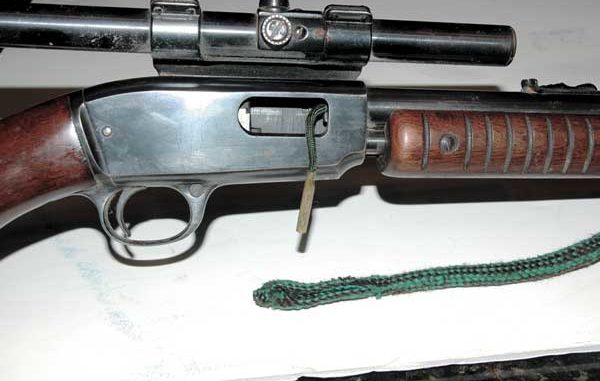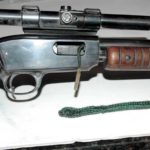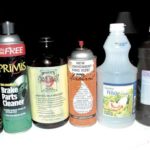
Here’s a look at some more trophies that were dropped during the 2007-08 season.
Each year I wonder how many sportsmen drag a firearm out of the closet in anticipation of the upcoming season, and find a patina of rust on the barrel or receiver, or worse, patches of rust that have actually eaten into the finish and marred it.
Now is the time to prepare your guns — most of them, anyway — for their long sleep until next season. Hopefully, you are going to take at least a few minutes and try to clean them properly before putting them away.
It’s easy to prepare a gun for storage, and doing it requires only a little preparation — planning that will ensure your investment in a fine piece of equipment is maintained, just like the metal you are trying to protect.
Most folks don’t shoot their centerfire rifles very much. Once deer season is over, the gun is (hopefully) wiped down with a proper gun oil or any decent lightweight oil, and placed in a dry place of storage. But for some reason, many will not clean the bore at all.
While those of us who shoot regularly will clean our bores more frequently because we are searching for that ultimate accuracy, most folks will shoot their rifles on the target range while checking zero, and then only very infrequently at game after that.
For the average hunter, as long as the barrel is kept dry during the hunting season, the barrel can be cleaned only once — at the end of the season.
For the rifles I am going to use strictly for hunting purposes, such as my Marlin .30-30, which may get hunted only a couple of times a season, my cleaning at the end of the season is the only time the bore will be really cleaned all year.
Bringing it out of the gun safe to test it, I know I’ll need a fouling shot because of the residue of rust preventative oil I left in the barrel at the end of the last season. I generally will run a patch through the bore that has been saturated with inexpensive brake parts cleaner. This is a great substitute for those cans of product known as gun scrubbers, and does the same thing.
Brake parts cleaner cuts and removes oils and petroleum products, and evaporates leaving a dry, clean bore. Once I have tested the rifle and found it still shooting accurately, I generally will not touch the bore again until the end of the season, when I will again clean it, and run a swab down it that has been saturated with a light gun oil such as RemOil.
One quick note here: A good substitute for brake parts cleaner is not carburetor cleaner. Carb cleaner is comprised of harsh chemicals designed to eat away distillates embedded in metal, and can damage finishes and ruin stocks. Even hard, rubber-type grips will melt from this stuff.
Of course, I will wipe the exterior metal down with a light oil, and when using it during the season, wipe it down with a light coat of oil after each day. Another handy thing to have is a silicone cloth, which is a lot neater than the oily rag, and easy to carry in a Ziploc bag. A silicone cloth will get the fingerprints off it, removing the acidic oils left from your skin. These will leave a very recognizable fingerprint in the finish of that fine firearm you treasure.
Quick note No. 2: Most gunsmiths of my acquaintance hate WD-40. I have heard several go so far as to tell people not to use it at all on a gun. An extreme I sometimes don’t follow. WD-40 is the most overused and abused protectant/lubricant in the gun world, simply because it doesn’t have the properties people are trying to get out of it.
WD-40 is a “water-displacement” tool. It is good for a quick touch-up in the field or to wipe down a firearm that has been in damp weather. It should be used only to protect the gun until a proper lubricant/protectant can be wiped or sprayed on the metal. It will not protect bare steel against oxidation for any length of time.
Spraying a healthy coating of WD-40 on a gun and putting it away for the rest of the year is almost a sure guarantee of a light coating of rust on your fine, blued-steel gun when you pull it out of storage nine months later. Take the time and wipe it down with a light coat of oil, clean the bore properly, and you will not have those moments of angst when your pride and joy, a little dusty, is pulled from the back of the closet for the beginning of the season.
For cleaning and preserving your guns year-round, an inexpensive kit with a rod and proper-sized brushes matching the bore of the guns is important, of course.
One of the most common bore solvents on the market, and still easy to find, is Hoppe’s No. 9. There are many different kinds available, with some chemically designed to remove metal fouling in barrels and perform all sorts of other duties, but for general cleaning purposes, any decent bore solvent will work.
Any firearm should be scrubbed from the chamber end. To run cleaning rods and tips into a barrel from the muzzle end is chancing damage to the lands, the raised parts of the barrel that engrave the rifling onto the jacket of the bullet, imparting the all-important “twist” that makes it fly accurately. If you damage the lands at the last point they touch the bullet, you can affect the accuracy of your gun severely.
But some guns, like lever-actions and semi-automatics with closed breeches, do not allow you to run a cleaning rod through the barrel from the chamber. If it is necessary to clean from the muzzle, an excellent choice is a Hoppe’s BoreSnake. These innovative cleaning tools come in different calibers, gauges and lengths to fit practically any barrel on the market. I have them in practically every caliber and gauge I own.
A brass tip is attached to the string, which is dropped through the barrel. The first part to touch the interior of the barrel is the floss portion — which has hundreds of times more cleaning surface than a patch. I like to saturate this with Hoppe’s or another bore cleaner.
Behind the floss is the bore brush, with much more scrubbing action than a standard brass or bronze brush. Behind that is the full floss area of the “snake,” which wipes out the bore, particles that have been loosened by the brush and the residual oil and cleaner.
On most guns, a couple of passes with a BoreSnake is all that is necessary. Saturate the first floss portion before the wire bristles with bore solvent. You do not need to re-apply the solvent with subsequent pulls.
If you have a gun that has become heavily leaded, such as a gun used in cowboy action shooting, or a .22 in which you have fired a lot of non-jacketed lead bullets, there is a way to loosen the junk, which can be literally formed into the chamber or barrel as if melted in place. I have had barrels so severely leaded, I was looking for an Outers Foul Out to borrow since I couldn’t scrub the lead out with any tool I could find.
Larry Arbour at Louisiana Gun & Reloading Supply in Baton Rouge kindly offered to loan me his kit, which removes lead and other metal impurities by placing a metal rod down the barrel with chemicals and then running an electric current through the rod. Electrolysis draws the metal impurities from the barrel to the rod, leaving a perfectly clean bore.
But before I tried that, he suggested a concoction he had used successfully over the years in cleaning many handguns fired thousands of times in competition.
He suggested mixing a 50/50 mixture of hydrogen peroxide and common white vinegar.
I was amazed to find this brew quickly loosened the lead plating in the barrel and chambers, and allowed it to be scrubbed away. When particles fell out of the gun, I took them and dropped them in the chemical, and watched them dissolve much like lead plates are eaten away by the acid in a battery.
Once I had the bore and chambers cleansed of lead, I coated them with a swab saturated with a light oil.
We don’t have as many worries as our grandfathers did in caring for our guns. The chemicals and cleaners on the market now will answer practically every need, and last a lot longer.
And the powders and primers are far less corrosive than they were just a generation ago. I have looked down the bores of more old shotguns than I care to remember to see rust spots eaten into the metal because someone didn’t take the time to simply push an oily rag through the barrel.
Nowadays, it only takes a minimal amount of care to protect your gun for a very long time once the season is over.
Shotgun barrels should be swabbed out and lightly oiled. Rifle and handgun barrels should be scrubbed, and lightly oiled also. If you do this once, for most folks, it will be needed only once each year, as long as you keep a good oil on the gun’s exterior to protect the finish and repel the rust.
Pull it out next year, run a patch through it that has been saturated with brake parts cleaner, and start having fun. Our guns are wonderful tools that give us great pleasure in so many ways. It is only right we give them the care and respect they deserve.
Gordon Hutchinson’s new book, The Great New Orleans Gun Grab, written with Todd Masson, editor of this magazine, is an expose’ of the gun confiscation scandal in New Orleans after Hurricane Katrina. Thousands of guns were illegally seized from private citizens trying only to protect their personal property. You can read about the book at www.neworleansgungrab.com.
Hutchinson’s first book, The Quest and the Quarry, is a generational tale that parallels the lives of a line of trophy bucks and the youth of a farming family that hunts them. It was chosen a Book of the Year by Southeastern Outdoor Press Association. It is a must-read for anyone interested in the quest for a trophy buck. You can read about it at www.thequestandthequarry.com.
Both books can be ordered on-line, or by calling (800) 538-4355.




